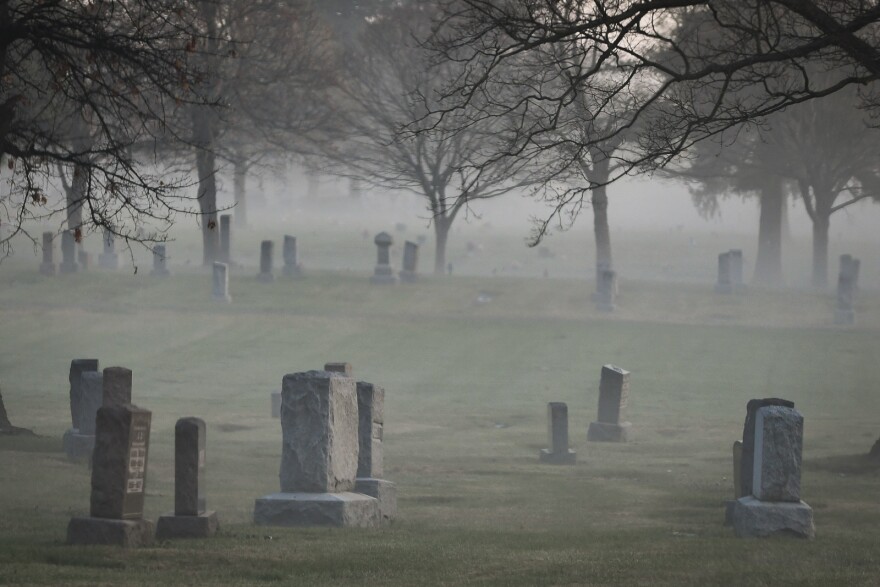On a misty autumn morning, it’s easy to imagine ghostly apparitions swirling through the shadows of any of our region’s 50 or so cemeteries. During the day, these parklike settings are oases of calm, testaments to the peaceful final rest we all should hope for. At night…. well, there are places the living should not frequent once the sun goes down.
A few of these historic cemeteries are reported to be haunted, with rumors of glowing figures appearing in the dark or following visitors through the grounds.
Whether you fancy a fright or a spiritual encounter, make sure to have permission before accessing these properties. Some are on private land and most of those accessible to the public are closed at night. Woe betide trespassers, who can incur a fine or worse, especially if the residents take offense. Beware!
Historic haunts

Neighboring Independence, Missouri, was founded in 1827 — before Kansas City — so it’s not a complete surprise that it allegedly hosts many ghosts.
Hill Park Cemetery sits on the northwest corner of Hill Park, formerly the private land of blacksmith Adam Hill and family. Starting in the 1830s, the quiet parcel of land was used as a graveyard, with Hill, his wife, and many descendants interred there, as well as Frank James and his wife, Ann Ralston. Surrounded by a stone wall, many of the tombstones are faded and some cracked.
The cemetery sits opposite a neighborhood of family homes that have built up around the park, with a skate ramp at the base of the hill. Supposedly, a “glowing, misty figure” is sometimes seen walking around the cemetery, possibly the final specter of an unknown Civil War soldier buried there.
Similarly, a ghostly figure of a woman purportedly appears in Mound Grove Cemetery. Founded in 1903 for the Reorganized Church of Jesus Christ of Latter Day Saints, this cemetery is the last resting place of Joseph Smith III (who died in 1914) and members of his family, among hundreds of others. Narrow lanes give access to rolling hills, some portions shadowed by large overhanging trees. The apparition follows visitors, but doesn’t venture beyond the gates.
Fort Leavenworth in Kansas was also founded in 1827 and has a fair amount of spectral activity documented in its history. The Fort Leavenworth National Cemetery was established in 1862, though burials started as early as 1844. According to “The Haunted Houses of Fort Leavenworth,” by John Reichley, back in the early days of the settlement, two children went missing during a storm. Their mother, Catherine Sutter, spent days and nights searching for them, eventually falling ill and dying.
In a twist, the children were delivered back to the fort in the spring, having spent the winter cared for by the local Native American tribe. So the story goes, Sutter can still be seen, holding a lantern, searching for her beloved children.
Connecting with the dead

While there are various strategies for paranormal investigation, perhaps the most pleasant way to commune with the dead is to keep them a part of the community.
Though now it’s a short drive from downtown along Truman Road, Elmwood Cemetery used to be out in the countryside and was considered the city’s first rural cemetery in 1872. It contains the remains of many of Kansas City’s earliest residents, including Kelsey Coates and Jacob Loose, as well as both Union and Confederate soldiers from the Civil War.
In “Missouri Hauntings,” Lee Prosser reports that orbs and unexplainable shadows are often witnessed, just beyond human vision. He writes: “Walking through Elmwood Cemetery is like walking through an active landmine of spirits.”
Today, there’s a push to bring more living folks to Elmwood to engage with its history. Ahead of the cemetery’s 150th anniversary, Brian Burnes reported on the cemetery for Flatland. On Nov. 3, Elmwood Cemetery Society hosts an Anniversary Walking Tour to celebrate its anniversary as a Level 1 Arboretum. Self-guided tours are available when the cemetery is open and public tours are available every third Saturday at 10 a.m., May through October.
Union Cemetery, founded in 1857, is the state’s oldest public cemetery, with more than 55,000 graves. It was created by the City of Kansas and Westport, due to the outgrown needs of their own cemeteries during a cholera epidemic. Generally, it’s a quiet pocket in the bustle of the city, but the graveyard’s history holds nefarious and underhanded dealings.
In 1989, KMBC’s Larry Morris reported on the tragic tale of Libby Mavis, a 12-year-old girl who was forced into prostitution and murdered in the late 19th century. After being buried in Union Cemetery, Libby appeared in a dream to her madam, saying that her grave had been robbed. When this dream was reported, it was discovered that the grave was indeed empty — and the mystery was never solved. Grave robbing was not uncommon in those days.
Later, parcels of Union Cemetery land were sold and developments built on top of the mass graves of the poor. Nowadays, the remaining land and its charges are protected, listed on the National Register of Historic Places. The Union Cemetery Historical Society provides a self-guided tour map featuring the gravesite locations of the cemetery's most well-known residents from Kansas City history.
As KCUR's Julie Denesha reports, a group of volunteers has cleaned more than 300 grave markers at Union Cemetery as a way of learning about and connecting with local history. The classes have proven to be so popular that the cemetery announced another session in early November.
Big Shoal Cemetery traditionally offers candlelight cemetery tours this time of year, exploring the history of Clay County. This year’s tours are sold out, but there is a waitlist.
Legends never die

Some cultures believe that a person is not completely dead as long as they are remembered. Kansas City has its share of famous (and infamous) residents whose legacies continue to impact the world today through art, business, politics and sports.
One of Kansas City’s most famous sons is saxophonist Charlie Parker. Over the course of his short life, he transformed jazz, carrying a new style from the clubs of 18th & Vine to the world. After his death in 1955, graffiti appeared throughout New York City proclaiming “Bird Lives.” Parker was brought back to Kansas City and buried in Lincoln Cemetery. Musicians gather at his gravesite each year on Aug. 29 — his birthday — and offer a saxophone salute.
Satchel Paige and Buck O’Neil were legends on and off the baseball field. They were part of the Negro Leagues’ Kansas City Monarchs and both became Hall of Famers. Though Paige was inducted in 1971, O’Neil’s acknowledgement was a long time coming, awarded posthumously in 2022.
Their graves are in Forest Hill & Calvary Cemetery, along Troost Avenue. Paige’s monument is inscribed with “How To Stay Young,” passing along his good advice — such as, “Don’t look back. Something might be gaining on you” — to future generations. There’s also a Satchel Paige Memorial Stadium on 51st Street, managed by Kansas City Parks and Recreation.
Some visitors may not realize that along Brush Creek and Rockhill Road, tucked into the beautiful flora of the Ewing and Muriel Kauffman Memorial Garden, are the graves of that Kansas City power couple. Their contributions to the community continue to influence the city today, with the Kauffman Foundation, Kauffman Stadium and (with Muriel’s daughter Julia fulfilling her mother’s dream) the Kauffman Center for the Performing Arts.
Discovering the unknown

There is a particular tragedy to the graves of the unnamed. Unmarked graves haunt historians and genealogists as they try to unravel the mysteries and stories of victims of cholera and battle, young children, poor and enslaved people. These people were buried in either unmarked graves or given generic markers: stones or crosses with no identifying information.
Various historians, genealogists, and societies associated with local cemeteries work to document and honor those buried within their walls. Time is against them, as even the marked graves of individuals can be damaged by vandalism and faded through exposure, erasing what little information there was.
In Weston, Missouri, a monument stands naming some of the 400 African Americans (both free and enslaved) who are buried in Laurel Hill Cemetery, many in unmarked graves. The monument was dedicated in 2020. There are still 33 graves left unidentified.
A similar project is underway in Liberty, Missouri, to identify and honor those buried in segregated sections of the Fairview and New Hope Cemeteries. The Liberty African American Legacy Memorial was dedicated this past June. Of more than 700 people buried in these cemeteries, many have been documented, though researchers continue to uncover more of their stories.
There are also mass graves for Civil War soldiers, as well as monuments for both Union and Confederate dead. In Independence, the small Pitcher Cemetery holds mass graves for both cholera victims and the Civil War's fallen, as well as “pioneer” markers — which are stones used to designate graves. Supposedly, ghostly soldiers can sometimes be seen marching through the cemetery at night.






